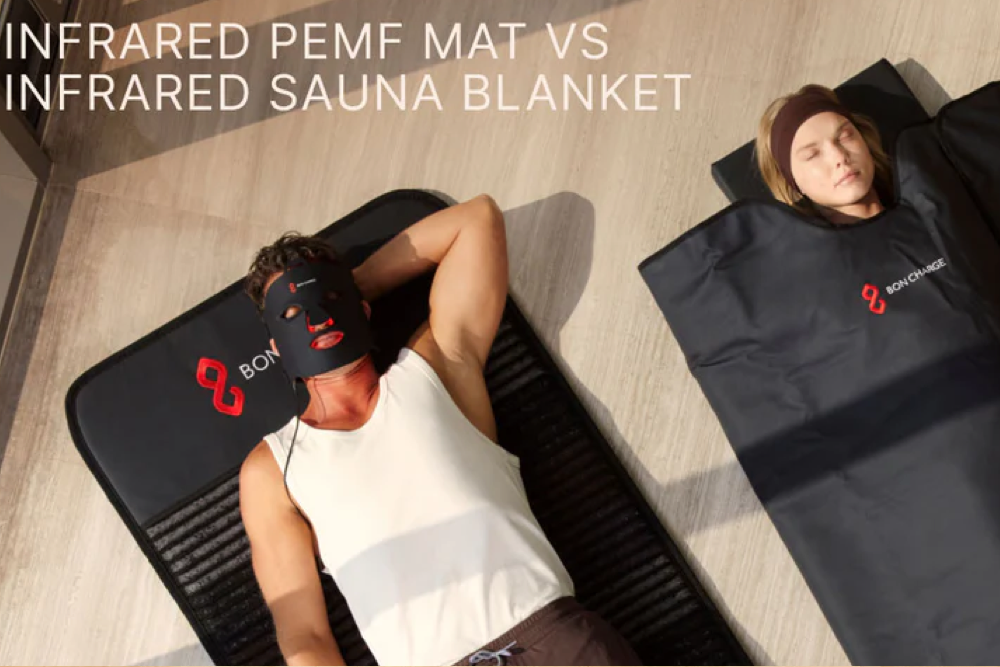- HOME
- Best PEMF Mats of 2025 – In‑Depth Reviews & Guide
- PEMF vs Infrared: A Comparison
PEMF vs Infrared: Core Differences & Clinical Uses

Recently, infrared PEMF mats have become the hype wellness industry. Companies like HealthyLine, Bon Charge, and HigherDOSE are at the forefront of this trend, selling innovative products that combine PEMF therapy and infrared therapy. Both therapies have specific benefits that naturally help your body recover. So, what exactly are the key differences between PEMF and infrared therapy and how do these therapies work together to support your health? Let's take a closer look.
Here's a quick rundown of the blog post:
Comparison table PEMF and Infrared Therapy
| Feature | PEMF Therapy | Infrared Therapy |
|---|---|---|
| Technology | Uses low-frequency electromagnetic fields (1-30 Hz) | Uses infrared light waves within the terahertz frequency range (0.3-400 THz) |
| Mechanism | Stimulates cellular repair and supports cellular function by influencing the body’s electromagnetic field | Penetrates deep into tissues, generating heat that improves circulation and muscle relaxation |
| Penetration Depth | Targets cellular level with penetration varying by frequency and intensity | Penetrates up to 1.5 inches into the body’s tissues |
| Primary Benefits | Improved circulation, reduced inflammation, pain relief, improved recovery | Deep tissue warming, detoxification, relaxation, improved circulation |
| Session Duration | Typically 10-20 minutes per session | Varies, often around 15-30 minutes for saunas, can be longer for lower temperature settings |
| Applications | Used in mats, pads, and wearable devices | Used in saunas (cabin, tents, blankets), mats, pads, therapeutic lamps, and wearable garments |
| Frequency Range | 1-30 Hz | 0.3-400 THz |
| Heat Generation | Does not generate heat | Generates heat |

What is PEMF Therapy?
PEMF (Pulsed Electromagnetic Field) therapy uses low-frequency electromagnetic fields, typically in the Hertz (Hz) range, to stimulate cellular repair and healing [1]. Imagine tiny pulses of energy moving through your body, like gentle ocean waves. These waves interact with your body's natural electromagnetic field.
👉 PEMF Mat Therapy - How Does PEMF Work?
How PEMF Therapy Works
The electromagnetic waves re-energize damaged cells, by influencing the body's natural electromagnetic field, amping up cellular function and promoting healing. When PEMF waves pass through your body, they increase the spin of electrons in your cells, akin to turning a key to start a car engine. This energizing effect helps cells function more efficiently, which is particularly beneficial for areas experiencing pain or inflammation.

Gemstone Heat Therapy For Healing, Deep Relaxation & Self-Care
Benefits of PEMF Therapy
🔹 Improved Circulation: The electromagnetic fields help dilate blood vessels, increasing blood flow and delivering more oxygen and nutrients to tissues [2].
🔹 Reduced Inflammation: PEMF therapy reduces inflammation by affecting cellular processes that cause inflammatory responses [3, 4].
🔹 Pain Relief: Reducing inflammation and the repair of damaged tissues relieves pain [5].
🔹 Recovery Support: PEMF therapy helps recharge cells, speeding up the repair of bones, muscles, and other tissue.
Learn more about the science behind PEMF for pain, PEMF for athletic recovery, PEMF for sleep, PEMF for anxiety, PEMF for inflammation, and PEMF for Osteoarthritis.
practical Applications
PEMF therapy is used in various forms, such as mats, pads, and wearable devices. These applications are beneficial for treating conditions like arthritis, chronic pain, and sports injuries. The therapy sessions are usually brief, lasting about 10-20 minutes, and can be done at home with portable PEMF devices.
In summary, PEMF therapy is a non-invasive, safe, and effective method to support your body's natural healing processes by using low-frequency electromagnetic waves to recharge and rejuvenate your cells.

The Best Infrared Sauna Blanket Reviews
What is Infrared Therapy?
Infrared therapy uses infrared light waves, which fall within the Terahertz frequency range, to generate heat that penetrates deep into the tissues. This process optimizes circulation and muscle relaxation [6]. The specific frequencies used in infrared devices range from approximately 0.3 to 400 THz, targeting various depths for therapeutic effects, from superficial skin layers to deep muscle tissues.
How Infrared Therapy Works
Infrared therapy works by emitting infrared light that goes through the skin and reaches deeper layers of tissue, up to 1.5 inches beneath the surface. This penetration allows the light to be absorbed by water and proteins in the tissues, leading to several physiological effects.
When infrared light is absorbed by the skin, it triggers local cutaneous vasodilation (widening of the blood vessels) which increases blood flow and circulation in the area being treated. This helps supply more oxygen and nutrients to the tissues, promoting healing and reducing inflammation.

HigherDOSE Infrared Sauna Blanket
Benefits of Infrared Therapy
🔹 Deep Tissue Warming: The heat generated by infrared light permeates deeply, down into the muscles and joints, helping to relax and soothe muscle tension and stiffness.
🔹 Circulation Support: Infrared therapy widens blood vessels, increasing blood flow and helping deliver oxygen and nutrients to tissues more efficiently.
🔹 Detoxification: Infrared therapy induces sweating, which helps in the removal of toxins from the body.
🔹 Pain Relief: The therapy brings inflammation down and alleviates pain in conditions like arthritis, muscle strains, and other chronic pain issues.
🔹 Relaxation: The deep warmth facilitates a sense of relaxation and well-being.
Practical Applications
Infrared therapy is commonly used in saunas (cabins, tents, blankets), therapeutic lamps, mats, pads and wearable devices like infrared-emitting garments. Such applications help athletes recover from intense physical activities and ease chronic pain conditions.
In short, infrared therapy is a non-invasive, safe, and effective method to support your body’s natural healing processes by using infrared light to penetrate into tissues, support circulation, minimize pain, and sustain well-being.

Key Differences Between PEMF and Infrared Therapy
PEMF therapy and infrared therapy are both effective non-invasive treatments that support the body’s natural healing processes, but they operate in fundamentally different ways. We've outlined the differences so you can get a clear understanding of how each therapy works and what its unique benefits are.
Technology and Mechanism
🔹 PEMF Therapy: PEMF therapy uses low-frequency electromagnetic fields to recharge cells. These fields mimic the natural electromagnetic frequencies found in the environment, helping to restore cellular health and function. PEMF therapy increases electron spin in cells, which supports cellular activity and healing without producing heat.
🔹 Infrared Therapy: Infrared therapy employs light waves within the infrared spectrum to penetrate the skin and deeper tissues. This light generates heat, which is absorbed by water and proteins in the tissues, improving blood flow and muscle relaxation. The heat also induces sweating, which helps detoxify the body.

Blog post: Best PEMF Devices Compared: Infrared PEMF Mats vs PEMF-Only Devices
Penetration Depth and Heat Generation
🔹 PEMF Therapy: The depth of penetration in PEMF therapy varies depending on the frequency and intensity of the electromagnetic fields used. It primarily affects cells at a molecular level, re-energizing and repairing them.
🔹 Infrared Therapy: Infrared light can penetrate up to 1.5 inches into the body, reaching deeper tissues than other forms of light therapy. This penetration generates heat that relaxes muscles, invigorate circulation, and aids detox.

HealthyLine vs BEMER: A Real Comparison of Two Leading PEMF Mats
Primary Benefits
🔹 PEMF Therapy: Known for its ability to reduce inflammation and pain, PEMF therapy improves circulation and accelerates the healing of bones, muscles, and other tissues. It is particularly effective for conditions like arthritis, chronic pain, and sports injuries.
🔹 Infrared Therapy: The primary benefits of infrared therapy include deep tissue warming, which relaxes muscles and reduces stiffness, improved circulation, and detoxification through induced sweating. It also promotes relaxation and overall well-being.
Session Duration and Applications
🔹 PEMF Therapy: Sessions typically last between 10-20 minutes and can be performed using various devices such as mats, pads, and wearables. These devices make it easy to incorporate PEMF therapy into daily routines at home.
🔹 Infrared Therapy: Infrared therapy sessions can vary in duration. For example, infrared saunas usually require 15-30 minutes per session, but lower temperature settings might allow for longer sessions. Infrared therapy is commonly applied through saunas, therapeutic lamps, and garments that emit infrared light.

Synergy of PEMF and Infrared Therapy
The integration of PEMF and infrared therapies enables a comprehensive approach to health. While PEMF therapy works at the cellular level to charge cells, infrared therapy penetrates deeper into tissues, resulting in. 👉 PEMF Mat Therapy: Clinical Evidence & Application Guide.
Here are some of the benefits, and if you’re curious about the tech behind it, check out our blog post that explains how infrared and PEMF work together.
Improved Circulation
Both therapies improve blood flow on their own. When used together, they boost circulation further, helping deliver oxygen and nutrients to tissues more effectively and supporting faster healing.
Pain Relief
PEMF therapy reduces pain by decreasing inflammation and repairing damaged cells. Infrared therapy complements this by relaxing muscles and easing tension, providing immediate and lasting pain relief.
Detoxification and Relaxation
Infrared therapy induces sweating, which helps detoxify the body. When combined with PEMF therapy’s ability to restore cellular health, the body’s natural detoxification processes are optimized, leading to a more thorough and effective cleanse.
Accelerated Healing
By combining the cellular repair benefits of PEMF with the deep tissue penetration of infrared, these mats can accelerate the healing of injuries and reduce recovery time. This makes them particularly beneficial for athletes and individuals with chronic pain conditions.
Overall Well-Being
Improved circulation, reduced pain, detoxification, and faster healing work together to support overall well-being. Users often report feeling more relaxed, energized, and healthier overall after regular use.

When to Choose Infrared, PEMF, or a Combined Approach
When deciding between infrared therapy, PEMF therapy, or a combination of both, it's important to consider your specific health needs and wellness goals.
Infrared therapy is ideal if you are looking to:
🔹 Improve Circulation and Relaxation: Infrared therapy penetrates deeply to improve your blood flow and relax muscles, making it great for reducing stiffness and enhancing relaxation.
🔹 Detoxify: The heat generated by infrared light make you sweat, which helps detoxify the body.
🔹 Relief Pain From Muscle Tension: If your pain is related to muscle tightness or stress, the warming effect of infrared therapy can be particularly beneficial.
PEMF therapy is best suited for people who need to:
🔹 Reduce Inflammation: PEMF therapy targets cellular inflammation and heals at the cellular level.
🔹 Accelerate Healing: Ideal for injuries or chronic conditions that need faster recovery times.
🔹 Support Cellular Function: PEMF therapy helps recharge cells to maintain their health and activity.

PEMF Combination Therapy Guide
A combined approach using infrared PEMF mats can provide the best of both worlds, especially if you:
🔹 Have Complex Health Needs: Combining both therapies can address multiple issues simultaneously, such as chronic pain, poor circulation, and muscle tension.
🔹 Seek Comprehensive Wellness: For overall health, combining both therapies supports detoxification, pain relief, and cellular repair more effectively than either alone.
🔹 Need Athletic Recovery: Athletes or people with high physical demands can benefit from the combined effects described above.
PEMF vs Infrared Pros and Cons
| Feature | Infrared Therapy | PEMF Therapy |
|---|---|---|
| Pros |
- Deep tissue warming - Reduces inflammation - Improves circulation - Muscle relaxation (immediate pain relief) - Detoxification |
- Supports cellular repair - Promotes healing - Improves cellular function - Requires consistent use for best results |
| Cons |
- Can cause dehydration if not managed - May not penetrate as deeply for all conditions |
- May not provide immediate pain relief like infrared - Requires consistent use for best results |
| Ideal For | Muscle pain, stress, detoxification | Inflammatory conditions, chronic pain |
If you want to explore the science behind these therapies in more detail, visit our blog at saunace.com. We have also reviewed popular infrared PEMF mats including BON CHARGE, HealthyLine, HigherDOSE, Hooga, Grooni, and more to help you compare features, performance, and value across the board.
Saunace.com publishes reviews and usage guides for infrared and PEMF devices to help readers compare options and use them safely; see the About page to learn how we research and evaluate products.
Saunace is supported by its audience. When you purchase through links on our website, we may earn an affiliate commission. Learn more.

Sam Everhart
Updated: July 2025
You might find the following blog posts helpful
References
1. Luigi Cristiano and Tiziano Pratellesi, Mechanisms of Action And Effects of Pulsed Electromagnetic Fields (PEMF) in Medicine, ResearchGate, https://www.researchgate.net/publication/346945355
2. Glenn M Stewart et al., Impact of pulsed electromagnetic field therapy on vascular function and blood pressure in hypertensive individuals, PubMed, https://pubmed.ncbi.nlm.nih.gov/32401418/
3. Xiaotian Yang et al., Effects of Pulsed Electromagnetic Field Therapy on Pain, Stiffness, Physical Function, and Quality of Life in Patients With Osteoarthritis: A Systematic Review and Meta-Analysis of Randomized Placebo-Controlled Trials, PubMed, https://pubmed.ncbi.nlm.nih.gov/32251502/
4. Massimo Giovale et al., Low-energy Pulsed Electromagnetic Field Therapy Reduces Pain in Fibromyalgia: A Randomized Single-blind Controlled Pilot Study, PubMed, https://pubmed.ncbi.nlm.nih.gov/36465321/
5. Teresa Paolucci et al., Electromagnetic Field Therapy: A Rehabilitative Perspective in the Management of Musculoskeletal Pain - A Systematic Review, PubMed, https://pubmed.ncbi.nlm.nih.gov/32606905/
6. Fatma Vatansever and Michael R. Hamblin, Far infrared radiation (FIR): its biological effects and medical applications, PubMed, https://www.ncbi.nlm.nih.gov/pmc/articles/PMC3699878/


